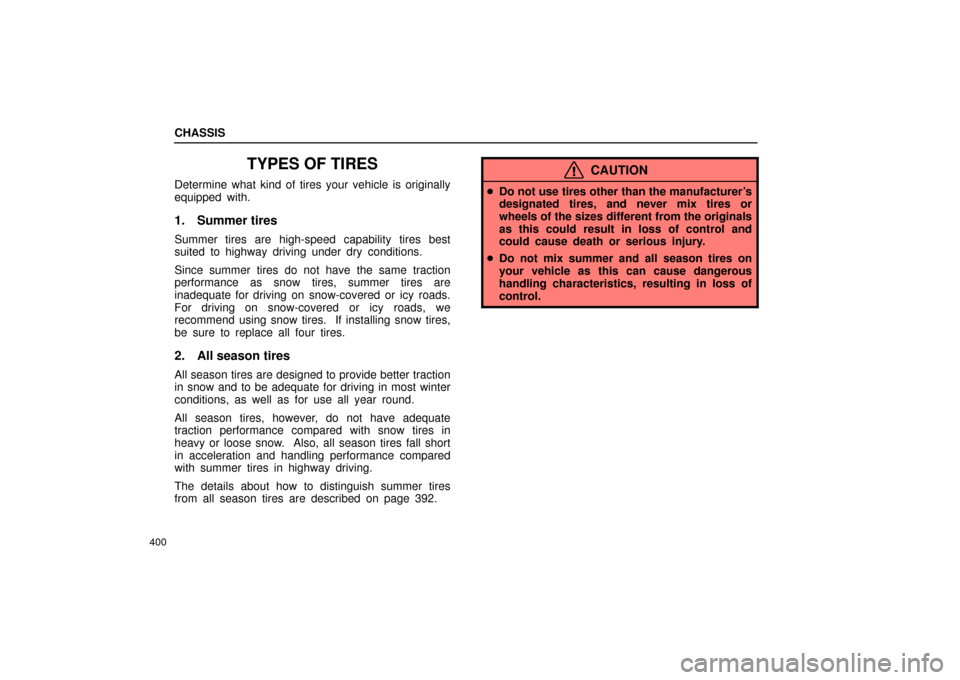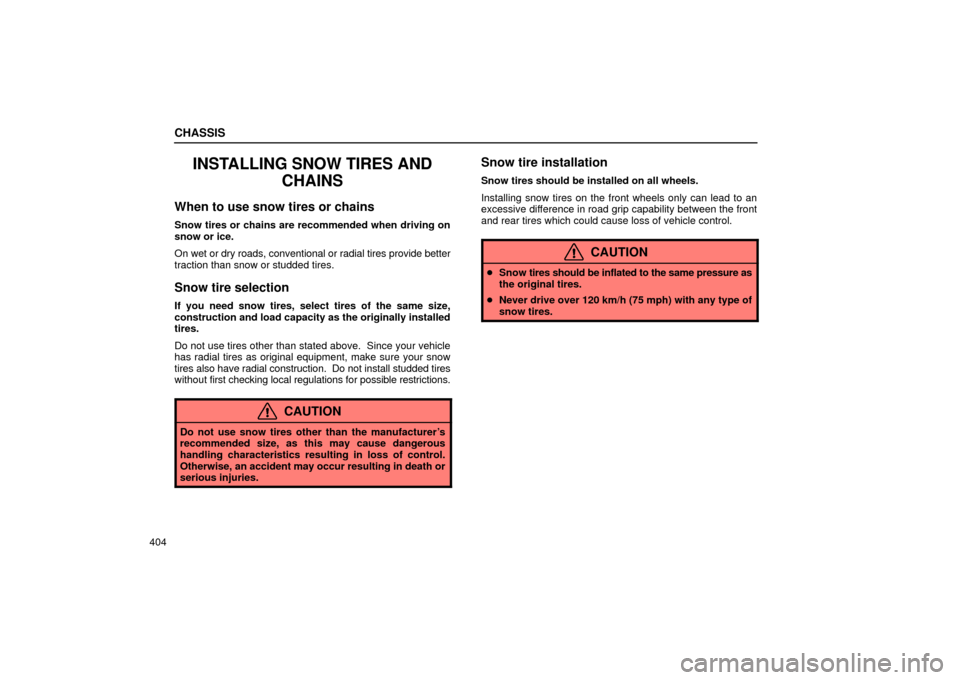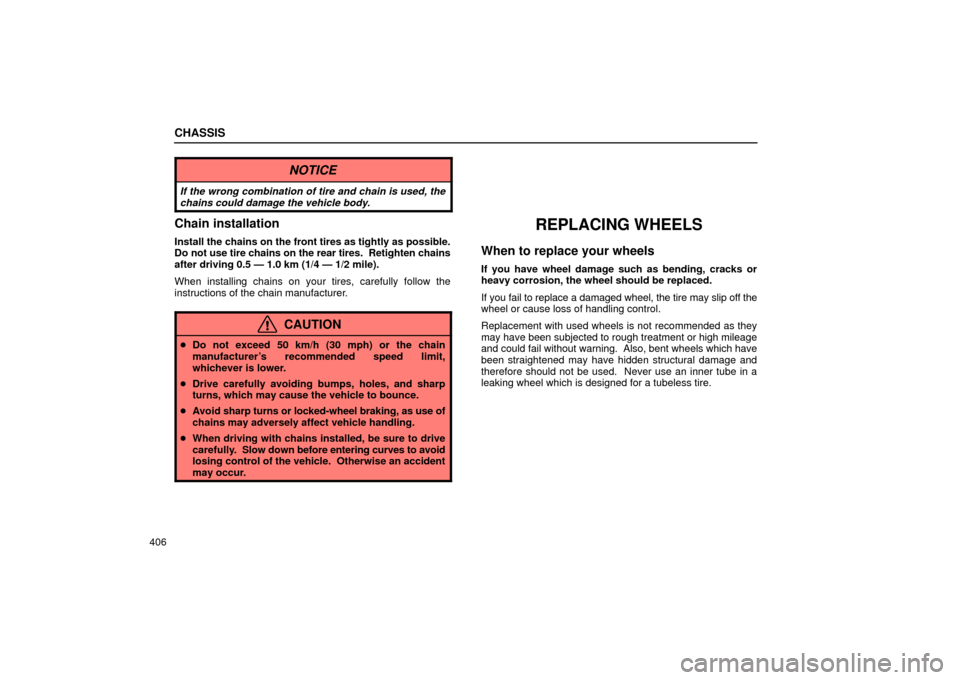Page 423 of 482

CHASSIS
398
Production options
weightThe combined weight of those installed regular production options weighing over 2.3
kg (5 lb.) in excess of those standard items which they replace, not previously
considered in curb weight or accessory weight, including heavy duty brakes, ride
levelers, roof rack, heavy duty battery, and special trim
Vehicle capacity
weight
(Total load capacity)The rated cargo and luggage load plus 68 kg (150 lb.) times the vehicle's designated
seating capacity
Intended outboard
sidewall(a) The sidewall that contains a whitewall, bears white lettering or bears
manufacturer, brand, and/or model name molding that is higher or deeper
than the same molding on the other sidewall of the tire, or
(b) The outward facing sidewall of an asymmetrical tire that has a particular side
that must always face outward when mounted on a vehicle
Occupant distributionDistribution of occupants in a vehicle as specified in the third column of Table 1 that
follows
RimA metal support for a tire or a tire and tube assembly upon which the tire beads are
seated
Rim diameter (Wheel
diameter)Nominal diameter of the bead seat
Rim size designationRim diameter and width
Rim type designationThe industry of manufacturer's designation for a rim by style or code
Rim widthNominal distance between rim flanges
Page 425 of 482

CHASSIS
400
TYPES OF TIRES
Determine what kind of tires your vehicle is originally
equipped with.
1. Summer tires
Summer tires are high-speed capability tires best
suited to highway driving under dry conditions.
Since summer tires do not have the same traction
performance as snow tires, summer tires are
inadequate for driving on snow-covered or icy roads.
For driving on snow-covered or icy roads, we
recommend using snow tires. If installing snow tires,
be sure to replace all four tires.
2. All season tires
All season tires are designed to provide better traction
in snow and to be adequate for driving in most winter
conditions, as well as for use all year round.
All season tires, however, do not have adequate
traction performance compared with snow tires in
heavy or loose snow. Also, all season tires fall short
in acceleration and handling performance compared
with summer tires in highway driving.
The details about how to distinguish summer tires
from all season tires are described on page 392.
CAUTION
�Do not use tires other than the manufacturer's
designated tires, and never mix tires or
wheels of the sizes different from the originals
as this could result in loss of control and
could cause death or serious injury.
�Do not mix summer and all season tires on
your vehicle as this can cause dangerous
handling characteristics, resulting in loss of
control.
Page 426 of 482
CHASSIS
401
ROTATING TIRES
To equalize tire wear and help extend tire life,
Lexus recommends that you rotate your tires
according to the maintenance schedule. (For
scheduled maintenance information, please refer
to the Owner's Manual Supplement/Scheduled
Maintenanceº.) However, the most appropriate
timing for tire rotation may vary according to your
driving habits and road surface conditions.
The wheel assemblies must be rotated as illustrated
above.
When rotating tires, check for uneven wear and
damage. Abnormal wear is usually caused by
incorrect tire inflation pressure, improper wheel
alignment, out-of balance wheels, or severe braking.Before storing radial, snow or studded tires, mark the
direction of rotation and be sure to install them in the
same direction when using them again. Tires should
be stored in a cool dry place.
Page 429 of 482

CHASSIS
404
INSTALLING SNOW TIRES AND
CHAINS
When to use snow tires or chains
Snow tires or chains are recommended when driving on
snow or ice.
On wet or dry roads, conventional or radial tires provide better
traction than snow or studded tires.
Snow tire selection
If you need snow tires, select tires of the same size,
construction and load capacity as the originally installed
tires.
Do not use tires other than stated above. Since your vehicle
has radial tires as original equipment, make sure your snow
tires also have radial construction. Do not install studded tires
without first checking local regulations for possible restrictions.
CAUTION
Do not use snow tires other than the manufacturer's
recommended size, as this may cause dangerous
handling characteristics resulting in loss of control.
Otherwise, an accident may occur resulting in death or
serious injuries.
Snow tire installation
Snow tires should be installed on all wheels.
Installing snow tires on the front wheels only can lead to an
excessive difference in road grip capability between the front
and rear tires which could cause loss of vehicle control.
CAUTION
�Snow tires should be inflated to the same pressure as
the original tires.
�Never drive over 120 km/h (75 mph) with any type of
snow tires.
Page 431 of 482

CHASSIS
406
NOTICE
If the wrong combination of tire and chain is used, the
chains could damage the vehicle body.
Chain installation
Install the chains on the front tires as tightly as possible.
Do not use tire chains on the rear tires. Retighten chains
after driving 0.5 Ð 1.0 km (1/4 Ð 1/2 mile).
When installing chains on your tires, carefully follow the
instructions of the chain manufacturer.
CAUTION
�Do not exceed 50 km/h (30 mph) or the chain
manufacturer's recommended speed limit,
whichever is lower.
�Drive carefully avoiding bumps, holes, and sharp
turns, which may cause the vehicle to bounce.
�Avoid sharp turns or locked-wheel braking, as use of
chains may adversely affect vehicle handling.
�When driving with chains installed, be sure to drive
carefully. Slow down before entering curves to avoid
losing control of the vehicle. Otherwise an accident
may occur.
REPLACING WHEELS
When to replace your wheels
If you have wheel damage such as bending, cracks or
heavy corrosion, the wheel should be replaced.
If you fail to replace a damaged wheel, the tire may slip off the
wheel or cause loss of handling control.
Replacement with used wheels is not recommended as they
may have been subjected to rough treatment or high mileage
and could fail without warning. Also, bent wheels which have
been straightened may have hidden structural damage and
therefore should not be used. Never use an inner tube in a
leaking wheel which is designed for a tubeless tire.
Page 432 of 482

CHASSIS
407
Wheel selection
When replacing wheels, care should be taken to ensure
that they are equivalent to those removed in load capacity,
diameter, rim width, and offset.
Correct replacement wheels are available at your Lexus
dealer.
A wheel of a different size or type may adversely affect
handling, wheel and bearing life, brake cooling,
speedometer/odometer calibration, stopping ability, headlight
aim, bumper height, vehicle ground clearance, and tire or snow
chain clearance to the body and chassis.
CAUTION
Do not use wheels other than the manufacturer's
recommended size, as this may cause dangerous
handling characteristics resulting in loss of control.
Otherwise, an accident may occur resulting in death or
serious injuries.
ALUMINUM WHEEL PRECAUTIONS
�When installing aluminum wheels, check that the wheel nuts
are tight after driving your vehicle the first 1600 km (1000
miles).
�If you have rotated, repaired, or changed your tires, check
that the wheel nuts are still tight after driving 1600 km (1000
miles).
�When using tire chains, be careful not to damage the
aluminum wheels.
�Use only the Lexus wheel nuts and wrench designed for
your aluminum wheels.
�When balancing your wheels, use only Lexus balance
weights or equivalent and a plastic or rubber hammer.
�As with any wheel, periodically check your aluminum
wheels for damage. If damaged, replace immediately.